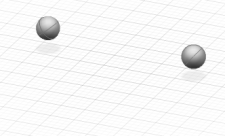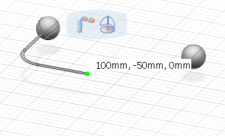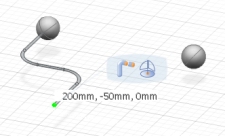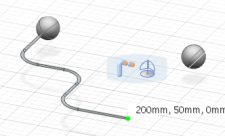Optional: In the specification tree or the 3D area, select the existing pathway set under which you want to create the new pathway.
Note:
If you do not make a selection, the pathway will be created under the current active node in the RFLP tree.
Open the Create Pathway command by doing one of the following:
- Click the arrow on the west quadrant of the Compass to open the toolbar and then in the toolbar click Create Pathway
 .
.
- Click .
A balloon appears: 
A pathway set is added to the RFLP tree under the active system or sub-system. It contains one pathway and one segment. The pathway set name is automatically generated by the system (however you can modify the name; right-click the name in the RFLP tree and select ).
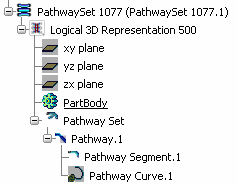
Optional: To set options for the pathway, in the balloon click  .
.
The Pathway Options dialog box appears.
Define your options and then click Close.
Optional: To set offset options, in the balloon click  .
.
The Define offset mode and offset value dialog box appears.
Define your options and then click Close.
If necessary, you can reopen this dialog box at any time while you are creating the pathway.
In the balloon, select a point positioning mode:
 Basic Creation Mode: Move the pointer in the 3D area; it will detect Pathway Branch Points,
Pathway Connection Points (PCP), 3D points, and points and surfaces on 3D shapes. Hold down Ctrl to create passing points offset from a shape. To reverse the offset direction, also hold down Shift.
Basic Creation Mode: Move the pointer in the 3D area; it will detect Pathway Branch Points,
Pathway Connection Points (PCP), 3D points, and points and surfaces on 3D shapes. Hold down Ctrl to create passing points offset from a shape. To reverse the offset direction, also hold down Shift. Key-in XYZ Coordinates: Enter your own x, y and z coordinates for a point.
Key-in XYZ Coordinates: Enter your own x, y and z coordinates for a point. Route along robot base plane: Click in the 3D area to place a point on the robot base plane. Reposition the robot to change the base plane if necessary.
Route along robot base plane: Click in the 3D area to place a point on the robot base plane. Reposition the robot to change the base plane if necessary. Create New Point using Robot: Drag the robot; when you release, a point is created.
Create New Point using Robot: Drag the robot; when you release, a point is created.
Use the point positioning mode selected (or a combination of any of the modes) to create the pathway, going from point to point.
When you have finished your pathway, in the balloon click Exit Command  .
.
The pathway is created.
![]()
![]() :
: